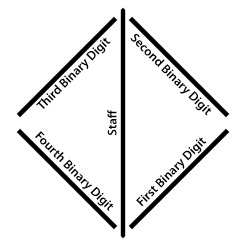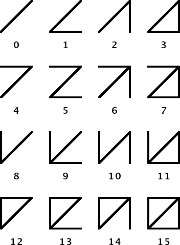018 Sinusoidal Sub-Digit Organization


Under Construction

This system uses binary sub digits also, but organizes them around the glyph. The sub digits are slanted to create diamond shapes.

Numbers can be converted to binary by reading off the digits in a snake like pattern running left to right.
Unfortunately, it doesn’t offer as much space compression as some of the other systems that I have.
The example above has been compressed visually, to the point where the glyphs touch each other. The result is somewhat confusing, gaps appear between some glyphs, while others seam together almost too well.
Aesthetics is not the main goal behind my research. I have created many variations of writing numerals across a range of different base systems. The real research is figuring out patterns in those variations and how they interact with each other. It may turn out that writing these diamond like glyphs in rows and columns on a piece of paper may produce easy methods for some mathematical procedure, or maybe I will find some mathematical procedure that shifts groups of four binary digits in a specific pattern. This is why I keep it around, it may provide a structure, later on, down the road.


If we wanted a tighter packing, something more legible, we could simply rotate the glyph 45 degrees. Very simple glyph structure, easy to write and easy to read.


The glyphs can be packed very tightly together, but would never be able to touch. It would probably take more effort to get used to a system like this. The sinusoidal pattern is there, but it’s slanted.
An interesting thing to note is that all odd binary sub digits are vertical, while all even digits are horizontal, but It’s my guess that this serves no benefit, and this is not the only variation that has this.

